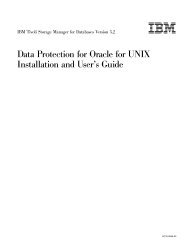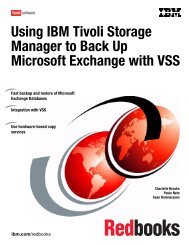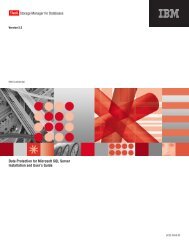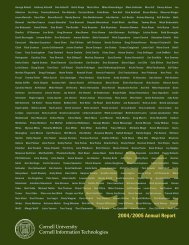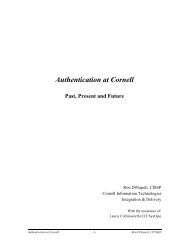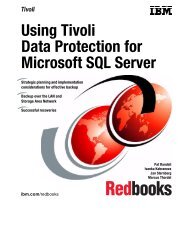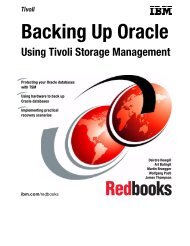Installation and User's Guide - Services and Support
Installation and User's Guide - Services and Support
Installation and User's Guide - Services and Support
You also want an ePaper? Increase the reach of your titles
YUMPU automatically turns print PDFs into web optimized ePapers that Google loves.
IBM Confidentialvolume-level copy mechanisms. The application can return to normal operations assoon as the hardware-assisted volume-level copy has been started <strong>and</strong> the logreplay is complete.The key component of producing a VSS Instant Restore is the speed with whichthe application can become operational with the data that resides on local shadowvolumes. Be aware that even though the data is restored relatively quickly, thetransaction logs must still be replayed after the restore <strong>and</strong> therefore, the time ofrecovery for the application can increase.Be aware that a VSS Instant Restore is only possible when all of the data (from thestorage group or database specified for restore) resides on storage subsystemssupported by the VSS Instant Restore. If part of the data being restored (includingthe log files) resides on a local disk, a VSS Instant Restore of this data is notsupported. In this situation, a VSS Fast Restore is performed.When performing a VSS Instant Restore, you must restore ALL databases withinthe specified storage group. You cannot perform a partial restore (/partial) whileusing VSS Instant Restore. Although Data Protection for Exchange allows thisoperation to begin, it will either fail or complete with undesirable consequences. Ifyou need to restore just one database from a VSS Backup that resides on local VSSshadow volumes on DS or SAN Volume Controller disks, make sure to select theDisable VSS Instant Restore option in the Data Protection for Exchange GUIRestore Window or specify /instantrestore=no on the comm<strong>and</strong> line interface. IfVSS Instant Restore capability is needed for single databases, make sure to placethese databases in their own storage group.Although VSS Instant Restore is the default restore method when all Exchangedata specified for restore resides on storage subsystems supported by the VSSInstant Restore, a failover to VSS Fast Restore can occur when an error is detectedearly enough in the VSS Instant Restore process to trigger the failover. In thissituation, an error is logged in the dsmerror.log file used by the DSMAGENT.However, a failover to VSS Fast Restore may not always be possible. For example,if an error occurs later in the restore process (such as a pending background copyon the storage subsystem, a failure to start the FlashCopy operation on thesnapshot provider system, or other hardware error), VSS Instant Restore processingfails without a failover to VSS Fast Restore.VSS Instant Restore does not support SSL for Common Information Model ObjectManager (CIMOM) communication. As a result, perform the following tasks beforeattempting a VSS Instant Restore:1. Configure the CIMOM server to accept communication without SSL byspecifying these values for the following options in the CIMOMcimom.properties file:Port=5988ServerCommunication=HTTPDigestAuthentication=falseSslEnabled=false (SVC only)Restart the CIMOM service after making these changes.2. If you are using SAN Volume Controller, you must also change theseWebSphere files so that they use the new CIMOM settings (the CIMOM islocated by default in the svcconsole directory):Chapter 1. Data Protection for Exchange Overview 13




